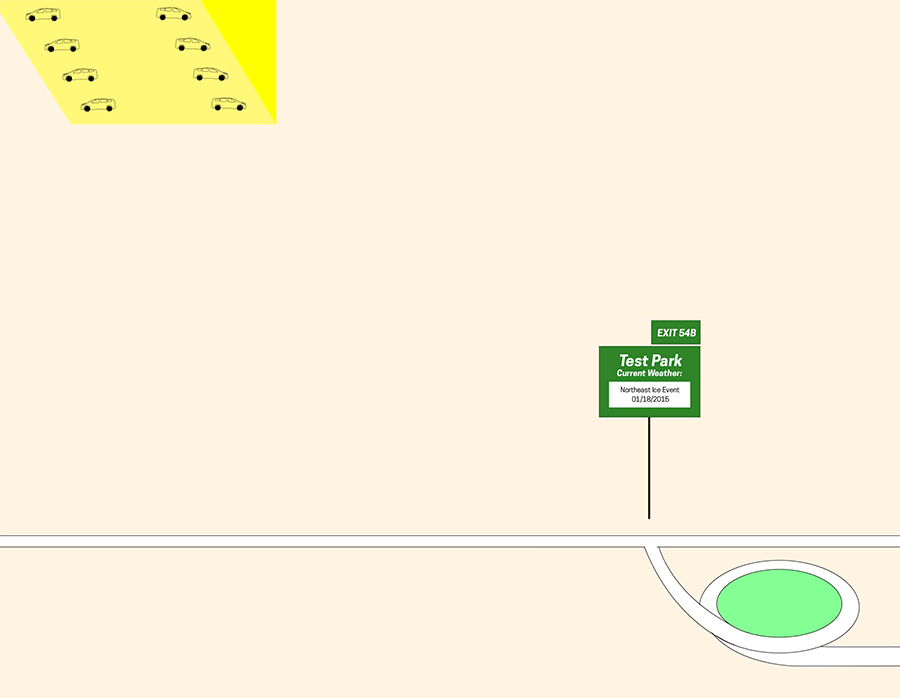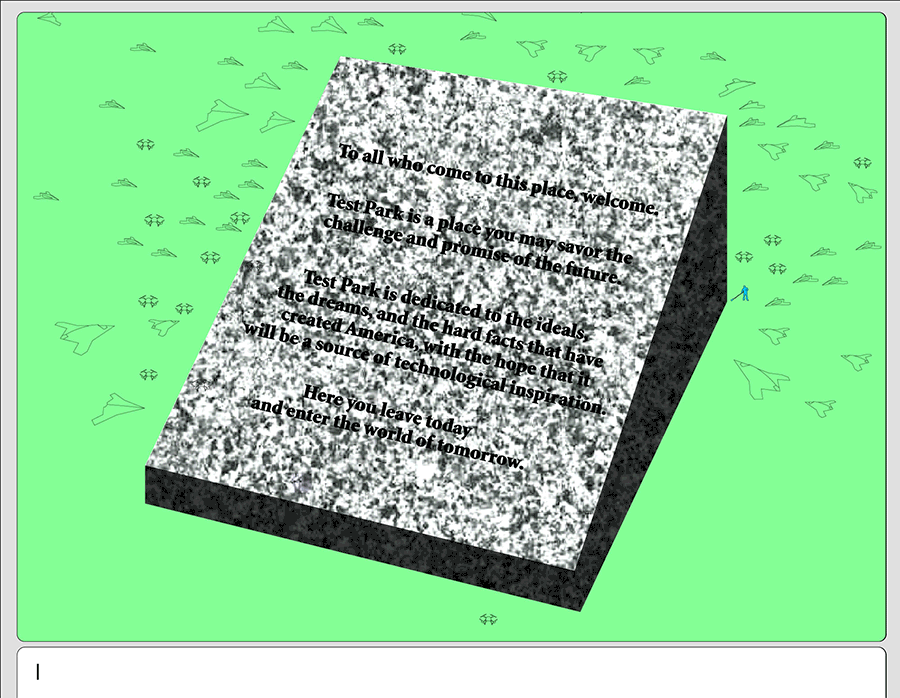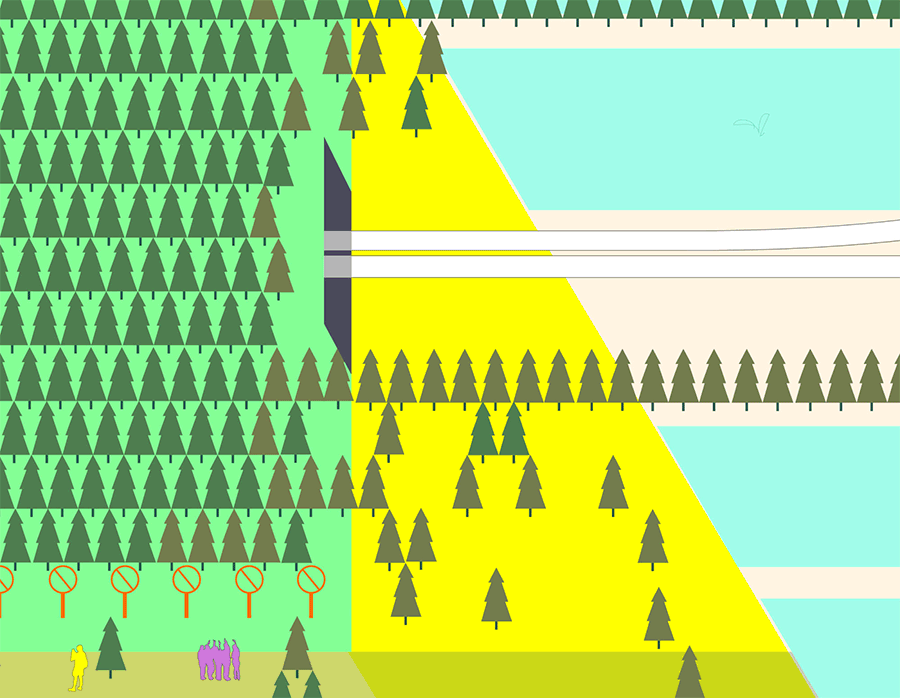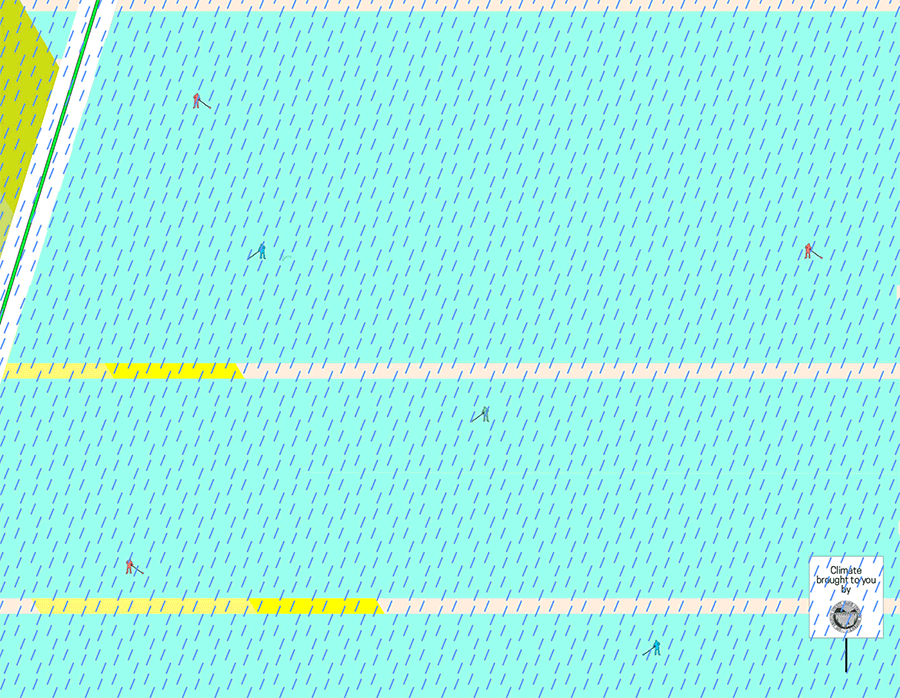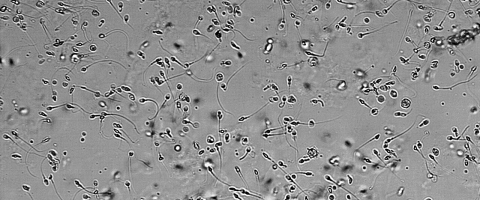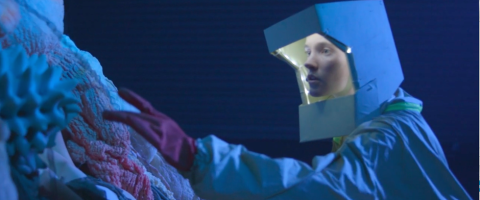From: Test Park <no-reply@testpark.com>
To: Test Park Variable Subscribers
Subject: Test Park Official Digital Outreach Announcement #4591
Go Test Park Tours:
Test Park includes sweeping views of the most experimental futures found in the United States – if not the world! Test Park Tours prides itself in showing you the National Test Park like no one else! We will introduce you to hidden gems, such as A. Leaky [2] End of the World Sanctuary [3]. Using the latest end of the world data, the sanctuary features droughts, heat waves, extra carbon dioxide, heat-trapping gases, human activity pollutants, car and power station emissions, and ozone. The mixture generates an atmosphere that will be found in years to come! Deep breath, because you can even camp inside this possible future!
For more information about Test Park please visit www.testpark.org.
Thank you for playing such an important role our research endeavors.
Test Park
Digital Outreach Research Department
“The futures you see maybe closer than they appear.”
No longer want to receive the updates from Test Park. Unsubscribe.
[1] Test sites are research reserves designated for experimental hypotheses and new technologies to roam free within real-world conditions. Typically built in remote locations, test sites expose once highly controlled, stable, and predictable experiments to the unpredictability of natural systems; the uncontrolled, the random, and the surprising. Operating as research free zones, test sites transcend the rule of law, empowering those within to explore alternative technologies, infrastructures, and policies – futures that are not yet publicly accessible. Despite test sites’ peripheral position they have major impact. Test sites are copied and pasted. Test sites are mimicked and modified. Test sites are prototyped places that become the models for our future neighborhoods, cities, and countries. Test sites spread.
While the freedom to experiment generates unique, autonomous places, test sites often exclude the unpredictability of public input and variable human interaction.
“We have not yet thought of the test site on the side of life.” — Ronell, Avital, The Test Drive
Utilizing a collection of existing test sites, Welcome to Test Park imagines a publicly accessible destination called Test Park. Through a series of fictional narratives, Welcome to Test Park guides visitors through futures currently envisioned by the U.S. government, scientists, and engineers. Test Park juxtaposes distant landscapes and futures, drawing inspiration from places designed for public interaction: narrative landscapes, tourist attractions, and theme parks like Disneyland – “a great collection of places… meant to stir the imagination. No matter how intense, how precise, how evocative, how specific the place where you are, you’re just a step away from a very different place.” — Architect, Charles Moore.
[2] Dr. Andrew Leakey is Associate Professor at The University of Illinois studying the effects of global warming on plants.
[3] The End of the World Sanctuary is based on The University of Illinois test farm in Savoy, Illinois called SoyFACE (Soybean Free Air Enrichment). The farm creates its own atmosphere to study how crops respond and adapt to climate change. — Gillis, Justin. “Testing Future Conditions for the Food Chain.” The New York Times. The New York Times, 22 Sept. 2014. Web. 24 Sept. 2014.
“Exit right to Test Park.”
Looking for Networks…
ATT512 (password protected)
belkin.d76 (password protected)
Bubble Bee Tuna (password protected)
The Smart Road: Main Street U.S.A. (open)
Weather Tower 19 (password protected)
Weather Tower 20 (password protected)
UAVPrecisionHawkLancaster1290 (password protected)
Status:
Connecting to The Smart Road: Main Street U.S.A…
Connected
High traffic.
Slow speeds.
“Welcome to Test Park! Your variable vehicle is currently traveling along The Smart Road [4], a classic representation of an American ‘people mover’ [5] – a talking road with 2 averaged suburban cul-de-sacs, a state-of-the-art fiber-optic backbone, in-pavement sensors, a data acquisition system, high speed wireless, 75 weather-making towers, 5 weather stations, and 24/7 surveillance.”
“The Smart Road’s current weather is a gentle mist, but has just collided with Climate Control Zone 2, creating a outbreak of severe thunderstorms… This weather update is brought to you by The Farmer’s Almanac, ‘Our main endeavor is to be useful, but with a pleasant degree of humor’ [6].”
[4] Maintained by the Virginia Department of Transportation, Virginia Tech’s Smart Road has future plans to connect to a public interstate. The Smart Road hosts public events and open houses annually.
[5] ‘People movers’ is a term adapted from Disney by architect and developer John Portman and is referenced by Fredric Jameson in Postmodernism and Consumer Society.
[6] Quote taken from The Old Farmer’s Almanac founder Robert B. Thomas.
Scenes from Go Test Park Tours:
Slide 1
Image: A highway cul-de-sac, a telescope surrounding by pine trees, a swarm of aerial vehicles, a field of wheat, a storm cloud, a mosquito release truck, a red desert, a cliff on the edge of darkness [7], and a granite dedication plaque in the foreground that reads:
“To all who come to this place, welcome. Test Park is a place you may savor the challenge and promise of the future. Test Park is dedicated to the ideals, the dreams, and the hard facts that have created America, with the hope that it will be a source of technological inspiration. Here, you leave today, and enter a place of tomorrow” [8].
Slide 1 Presenter Notes
(Read plaque text aloud). On behalf of all Test Park Official Staff and Citizens, we are so glad you could join us!
Slide 2
Image: Map of Test Park
Slide 2 Presenter Notes
Test Park was created for the display of our Nation’s most innovative technologies. It is a reserve created to support the release of future visions and foster the public’s relations with emerging technologies and infrastructures. Everything in Test Park has been designed specifically for native experiments to run wild within our nation’s landscape. It features futures as far as the eye can see.
Slide 3
Test Park Features:
Big: Test Park is 50,000 feet high, exists across 6 time zones, and every 144 hours (Test Park Time, TPT), one day passes.
Diverse: 13 climate zones, 46 states, 6,562 counties, 45,290 towns, 810,223 organisms, and 8 prototyped futures.
Slide 3 Presenter Notes
Test Park is truly a unique place. (Read slide text aloud). Test Park continues to expand, frequently updating and installing the latest speculations.
Slide 4
Tour Schedule:
008:000 Arrive at Temporary Variable Visitor Center (parking level G) via Smart Road for badging and briefing
009:000 Board bus
Depart for The Quiet Zone, home to The Forest of Technological Abandonment, and The Green Bank Telescope
017:000 Arrive at the edge of The Quiet Zone
Pass through The Electromagnetic Radiation Check Point
017:300 Depart for The Green Bank Telescope
019:000 Arrive at The Green Bank Telescope
Briefing on radio telescope research
Photographs with The Tree of Technological Abandonment [9]
025:000 Depart for The Monument of Technology and Silence Gift Shop
027:000 Arrive at The Monument of Technology and Silence Gift Shop
030:000 Depart for The GMO Fields
045:000 Arrive at The GMO Fields
048:000 View fields 1-32
Eat at The Farm to Table Food Court
046:000 Depart for When Humans Land on Mars
047:300 Arrive at When Humans Land on Mars
Four Wheel Rentals Available
Check-in Overnight Visitors
048:000 Depart for Climate Control Zone 8
055:000 Arrive at Climate Control Zone 8
059:000 Depart for The Unmanned Aerial Vehicle Airspace
064:000 Arrive at The Unmanned Aerial Vehicle Airspace
Pendleton, OR Med-High Test Range 46.0018 / -118.9761
View The PrecisionHawk Lancaster
065:000 Depart for Loiter Area Flt-Low Test Range 45.7913 / -118.9972
067:000 Arrive at Loiter Area Flt-Low Test Range 45.7913 / -118.9972
Registration for flying lessons
View The Aeryon Scout
Enter UAV Photo Zone, $1/0-75,000ft
078:000 Watch the GMMosquito Truck release
115:000 Depart for The End of the World Sanctuary
125:000 Arrive at The End of the World Sanctuary
Check-in Overnight Visitors
130:000 Depart for The Test Park Temporary Variable Visitor Center
144:000 Arrive back at The Test Park Temporary Variable Visitor Center
Drop off all Temporary Variables Visitors
Slide 4 Presenter Notes
Test Park’s is subdivided by futures:
The Smart Road [10], the latest in interactive Vehicle-to-Transportation-Infrastructure.
The soon to be publicly released, Unmanned Aerial Vehicle Airspace [11].
The Climate Controlled Zones. [12] Current weather is brought to you by the Groundwater District Rainfall Enhancement Program and Weather Modification Meet-up Member Jonathan Jan [13].
The End of the World Sanctuary [14].
The always expanding GMO Fields [15].
The Quiet Zone [16], home to The Forest of Technological Abandonment, and The Green Bank Telescope.
When Humans Land on Mars [17], located next to The Edge of The Impossible. This future is operated by the Mars Society and is estimated to be 15 years away.
And finally The GMMosquito Release Truck [18]. Dispersal processions occur every 30 minutes.
Slide 5
Test Site Prohibited Articles [19]:
No cameras
No camcorders
No cell phones
No Bluetooth enabled devices
No recording devices
No WiFi
No computers
No global positioning systems
No personal “drones”
No weapons
No explosives
No ammunition
No chemical irritants
No pets and animals
No binoculars
No optical instruments
No fans
No microwaves
No alcoholic beverages
and
No gum
Slide 5 Presenter Notes
Before we set off I’d like to remind everyone of the prohibited items (read list aloud emphasizing the “NO”)… Possession of these items may delay, prevent, or contaminate the futures being conducted within the park. If at any point during the tour these items are discovered your tour will be terminated. All Variable Visitors must also obey all park rules.
Test Park would also like all Variables Visitors to know that the park assumes no responsibility for injury and or damage to Variables as a matter of research liability. Thank you. Here, you leave today, and enter a place of tomorrow.
[7] “Theme parks, being postmodern, not only speak to many audiences but also bring opposite values together in one place and present them as a normal pairing… the landscape in one of today’s theme parks often does more than simply recollect an existing myth; it creates popular culture’s new ones”. — Young, Terence, and Robert B. Riley. Theme Park Landscapes: Antecedents and Variations. Washington, D.C.: Dumbarton Oaks Research Library and Collection, 2002. Print.
[8] Walter E. Disney’s dedication read at the opening of Disneyland July 17, 1955.
[9] The Tree of Technological Abandonment is a Test Park mascot. The tree features a cell phone, WiFi, and GPS jammer, representing the conditions of its home, The Quiet Zone.
[10] The Smart Road is based on the Virginia Tech Smart Road in Montgomery, Virginia.
[11] The Unmanned Aerial Vehicle Airspace is based on the FAA’s Commercial UAV Test Sites installed across the United State.
[12] The Climate Control Zones are based on the Weather Modification Test Sites in LA County.
[13] A member of the Los Angeles Weather Modification Test Site Meet-up Group.
[14] The End of the World Sanctuary is based on the Future of Food Production Farm in Savoy, IL.
[15] The GMO Fields are based on the Genetically Modified Test Farms across the United States.
[16] The Quiet Zone is based on The National Radio Quiet Zone in West Virginia, Virginia, and Maryland.
[17] When Humans Land on Mars is based on the Mars Desert Research Station in Utah.
[18] The GMMosquito Release Truck is based on the Mosquito Control District in Key West, Florida.
[19] Prohibited items based on The Nevada National Security Site Tour’s rules and restrictions.
The Quiet Zone:
017:000
Welcome to The Quiet Zone. You are currently standing on the edge of an impressive 13,000 square foot radio silence zone. That means no cell phones, laptops, WiFi, or televisions, anything that emits electromagnetic radiation. These radio waves can range from the size of a baseball to a soccer field. Should you see any, please let us know.
The Quiet Zone occasionally experiences instances of contamination. Past incidents have included: an interference from a battery-operated fan found in The Monument of Technology and Silence gift shop, a large bout of Flying Transmitter Test Squirrels, and a low flying ScanEagle from the neighboring UAV Airspace.
It can be quite difficult for people to be without their electronic devices on this tour [20]. If you are of a certain age, The Quiet Zone might give you a sense of nostalgia. In case of such emergency, please notify a member of our staff immediately.
019:000
We are now approaching the center of The Quiet Zone: The Robert C. Byrd Green Bank Telescope. You’ll be able to see the white disc emerging just over the tree line. That is The Green Bank Telescope, the reason why The Quiet Zone exists today. You can see the 100-meter diameter paraboloid from almost everywhere in The Quiet Zone, a constant reminder to zone citizens. It is perhaps one of Test Park’s most monumental structure. Variables Visitors make technological pilgrimages here from all over the world.
The telescope was erected in 1962 thanks to the late West Virginia Senator Robert C. Byrd who pushed the funding of the telescope through Congress. You can see his name is engraved at the base of the instrument. Measuring 555 feet in height, it is the same height as the Washington Monument and larger than the Statue of Liberty. The original structure was 500 feet, but collapsed in 1988. When it was rebuilt, the structure mysteriously gained an extra 55 feet. The Green Bank Telescope design has been copied across the world and can be seen on the side of many homes beyond Test Park.
This impressive engineering feat has been used to search for Extraterrestrial Intelligence, able to detect the of faintest of signals from distant galaxies 23,000 light years away. Although it is incredibly powerful it is also quite sensitive. The Green Bank Telescope is extremely susceptible to electromagnetic interference. This is why the surrounding area must maintain complete radio silence, a sort of technology dictatorship for this place. It even controls the weather [21] based on the research schedule utilizing the neighboring Climate Control Zones.
020:000
The Quiet Zone is one of the oldest places here in Test Park, over the years it has evolved, becoming home to a community of scientists, electromagnetic hypersensitives, ham radio hobbyists, low bandwidth radio station DJs, and people who believe in the “quiet life”, (a life without technology – except of course the huge telescope over there!) Cut off from the rest of society, The Quiet Zone exists as a sort of gated community, living in accordance to the Robert C. Byrd Green Bank Telescope’s ideology of no electromagnetic radiation [22].
The telescope is actually no longer in use, but it seems to have come to represent something more to this place.
025:000
[20] “[Theme parks] come into being and thrive only by opposing the chaos or ruin of the untamed and untidy mess beyond…” — Young, Terence, and Robert B. Riley. Theme Park Landscapes: Antecedents and Variations. Washington, D.C.: Dumbarton Oaks Research Library and Collection, 2002. Print.
[21] “’I remember one fella said the observatory would make it rain when they wanted it to and not rain when they didn’t want it to,’ say Harold Crist, a 90-year-old Green Bank native who also worked for the telescope at one time.” — Gaynor, Michael J. “Why People Are Moving to the Town Without Wi-Fi.” Washingtonian. N.p., 04 Jan. 2015. Web. 10 Jan. 2015.
[22] “Zoning technologies provide the mechanism for creating or accommodating islands of distinct governing regimes within the broader landscape of normalized rule, thus generating a pattern of variegated but linked sovereignty.” — Ong, Aihwa. The Chinese Axis: Zoning Technologies and Variegated Sovereignty. Journal of East Asian Studies: Jan.–Apr. 2004, Vol. 4, No. 1, pp. 69-96.
The GMO Fields:
045:000
Welcome to The Genetically Modified Fields, free of diseases and other pest problems! We just passed over an old cattle gate that marks the edge of the expansive GMO fields and where protestors are allowed to stand [23]. Please let us know if you would like us to stop and be let out.
The GMO Fields are cultivated collaboratively by Test Park researchers, Test Park farm advisors [24], and citizen farmers. Through this mutually beneficial partnership [25], Test Park can prototype genetically modified food varieties under natural pastoral growing conditions, while farmers can yield more crops utilizing the latest in agricultural technology [26].
Test Park proudly produces and distributes genetically modified seeds [27] through Test Park’s Seed Production and Archive Central. GM Seeds produced here have different traits. Many are “stacked”, containing multiple traits. The seeds are then used to grow experimental crop varieties. Field 14, marked “PROMISCUOUS” tends to spread beyond its approved boundaries. It is growing corn and NASAGravity-FDATolerant Soybeans©.
046:000
The farming process begins when the sites are first chosen through characterization [28]. The soil is then prepared and fertilized by the farmer. Then Test Park seeds are spread using methods like genetic seed drift, commingling, “volunteering”, prevailing winds, rain, equipment including planters, combines, balers, wagons, trucks, and storage like augers, elevators, bins, grain dryers, and rotary screen cleaners.
I’m sure you noticed that each field looks a bit different depending on the seed distribution method.
The field is then “closed in place” [29] and monitored as they grow, needing constant re-separation until the farmers harvest the crop and advisors harvest the data. See the field marked “DO NOT PICK!!!”? Surveillance is particularly intense before the crop and data are reaped.
047:000
A Climate Control Zone, a UAV Airspace, a When Humans Land on Mars, and an End of the World Sanctuary were recently installed within The GMO Fields! On your left is Field 10. It is growing Pro-Climate-Change-Ozone-Resistant Summer Sweet Squash©.
Next stop is lunch at The Farm to Table Food Court.
048:000
[23] The Nevada National Security Site has a gate and a set of bathrooms at the edge of the testing grounds for protestors.
[24] “Farm advisors first began appearing in the counties of California and many other states in the USA after passage of the 1914 Smith-Lever Act… A farm advisor’s primary responsibility is to asses the needs of growers in his or her county, and develop or adapt new techniques and technologies to address these issues.” — Henke, C. R. Making a Place for Science: The Field Trial. Social Studies of Science 30.4 (2000): 483-511. Web.
[25] “Field trials are places that are more than just a collection of soil, climate, bugs and other local conditions; places that are partly constituted by the practices that happen there… Thus, ‘making a place for science’ means more than simply turning it into a laboratory. If science is not crafted to address the local character of farming places and practices, the growers are unlikely to accept the research-based advice of advisors.” — Henke, C. R. Making a Place for Science: The Field Trial. Social Studies of Science 30.4 (2000): 483-511. Web.
[26] “Agricultural fairs paradoxically also reassure with technology. Despite the pastoral allusions of agricultural fairs, the economics of farming have been subject to dramatic, often volatile changes over the last hundred years. Harvests generally increased, but individual farm profits often declined because technologically supported competition steadily pushed commodity prices down… Farmers, and likely the suburbanites as well, are drawn to the agricultural fair’s confident message about technology. The agricultural fair offers a clear example of how contradictory myths are often intertwined at a theme park.” — Young, Terence, and Robert B. Riley. Theme Park Landscapes: Antecedents and Variations. Washington, D.C.: Dumbarton Oaks Research Library and Collection, 2002. Print.
[27] “The city grows or changes because of the multipliers that circulate within – cars, elevators, mobile phones, laws, real estate formulas, structural innovations, and security technologies among them… While not offering comprehensive control over an organization, active forms can nevertheless be inserted to counterbalance or redirect a disposition. They can multiply across a field, recondition a population, or generate a network… Active forms establish a set of parameters for what the organization will be doing over time. They have time release powers and cascading effects.” — Easterling, Keller. Extrastatecraft: The Power of Infrastructure Space. London: Verso, 2014. Print.
[28] “Characterization” is the process of identifying the type, amount, and location of contamination. — Nevada National Security Environmental Management. “DOE – NNSA/NFO — Environmental Programs.” DOE – NNSA/NFO — Environmental Programs. Web. 12 Jan 2015.
[29] “Closed in place” occurs when contaminant of concern is left in place at the site. This method is used when the act of disturbing or removing contamination presents risks to workers that outweigh the benefits of removal and or the associated cost. — Nevada National Security Environmental Management. “DOE – NNSA/NFO — Environmental Programs.” DOE – NNSA/NFO — Environmental Programs. Web. 12 Jan 2015.
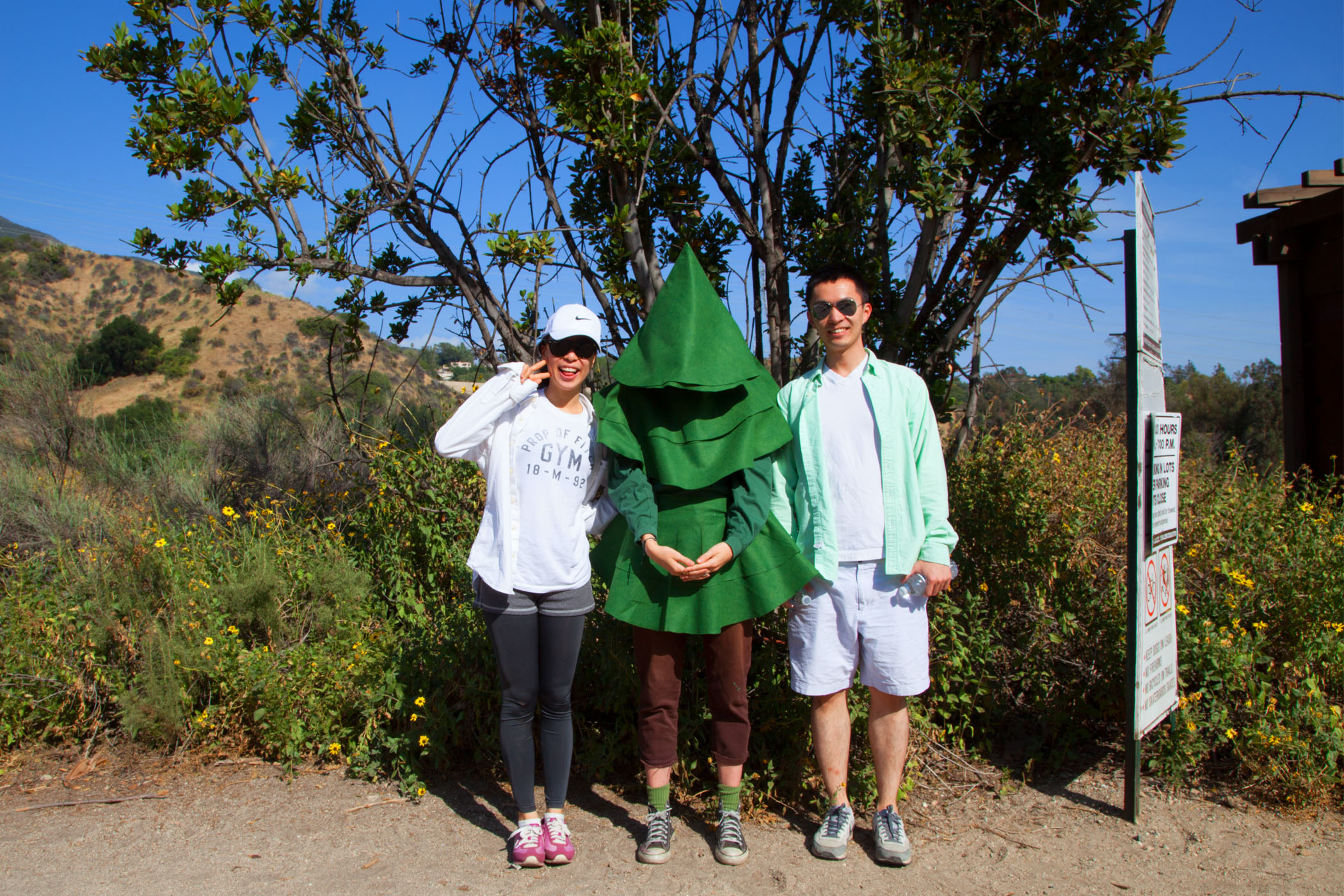
Image: A drawing of a small pine tree in front of a huge radio telescope with indistinguishable markings scrawled on it.
Notice Caption:
Test Park’s Robert C. Byrd Green Bank Telescope has been defaced.
This act of variable vandalism occurred between 008:000 – 012:000 TPT.
If anyone has any information please contact Sheriff David Jonese or Caretaker Mr. Wesley Sizemore [30] immediately.
304-456-2011
[30] — Gaynor, Michael J. “Why People Are Moving to the Town Without Wi-Fi.” Washingtonian. 04 Jan. 2015. Web. 22 Apr. 2015.
To: National Test Park <no-reply@testpark.com>
From: paul.koret@gmail.com
Subject: Test Park GMO-free Zone
This is notifying you of the recent motion introduced proposing a ban on all Test Park genetically modified crops, seeds, farmers, and fields from Los Angeles County. LA County would join San Juan County, Mendocino County, Marin County, and Arcata, as a GMO-free zone.
Currently there are none, however, this ban would symbolically protect the future possibility of Test Park GMO urban farming, while also creating a GMO free test site, a potential addition to Test Park [31].
Sincerely,
Paul Koretz, LA City Councilmen
Mitch O’Farrell, LA City Councilmen
Learning Garden and Seed Library of LA
The Los Angeles Garden Society
The LA Home-growers Associate
Heirloom Seed-Savers
Re:
From: National Test Park <no-reply@testpark.com>
To: paul.koret@gmail.com
Subject: [Auto Reply: This email does not accept incoming messages] Re: Test Park GMO-free Zone
You’ve written to an e-mail address that does not accept incoming messages.
Notice: By submitting comments and suggestions, you waive all rights to them and make them available for unrestricted research use.
No longer want to receive updates from Test Park. Unsubscribe.
[31] “As the zone mutates, it also resembles history’s various intentional communities with their mixtures of withdrawal and aspiration – mixing ecstatic expressions of urbanity with a complex and sometimes violent form of lawlessness. Maintaining autonomous control over a closed loop of compatible circumstances, the isomorphic zone rejects most of the circumstance and contradiction that are the hallmark of more familiar forms of urbanity… Yet, for all of these reasons, the zone is ripe for manipulation, and its popularity makes it a potential multiplier or carrier of alternative technologies, urbanities, and politics.” — Easterling, Keller. Extrastatecraft: The Power of Infrastructure Space. London: Verso, 2014. Print.
Welcome to Test Park was written as part of a graduate thesis design project in the Media Design Practices program at Art Center College of Design in Pasadena, California, with advice and support from Anne Burdick, Christina Agapakis, Tim Durfee, Shannon Herbert, Ben Hooker, Alan Koch, and Mimi Zeiger.


